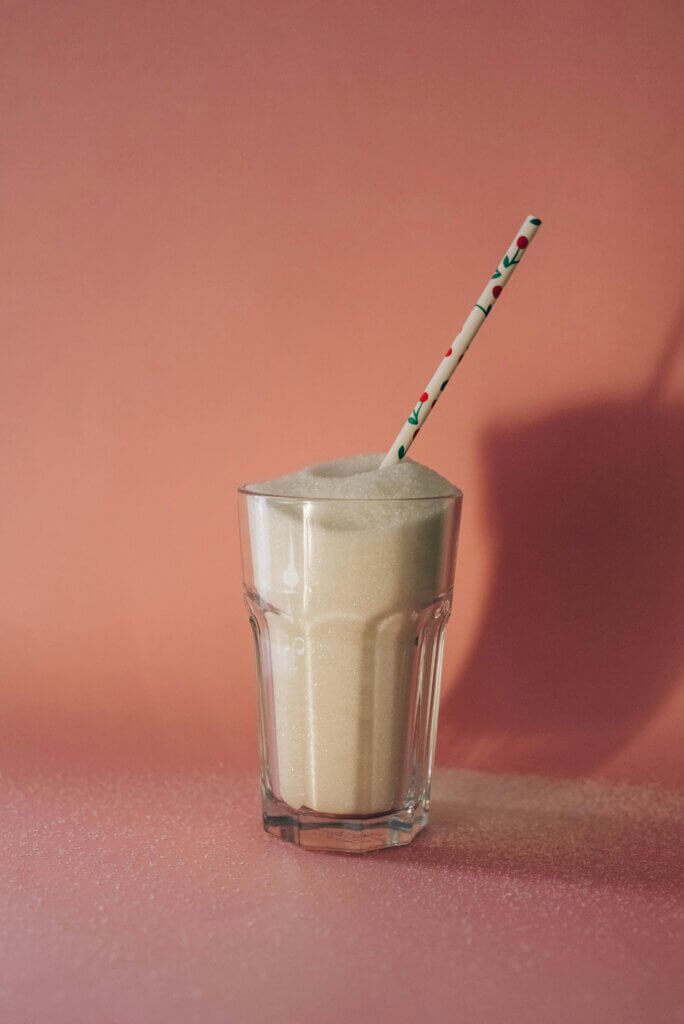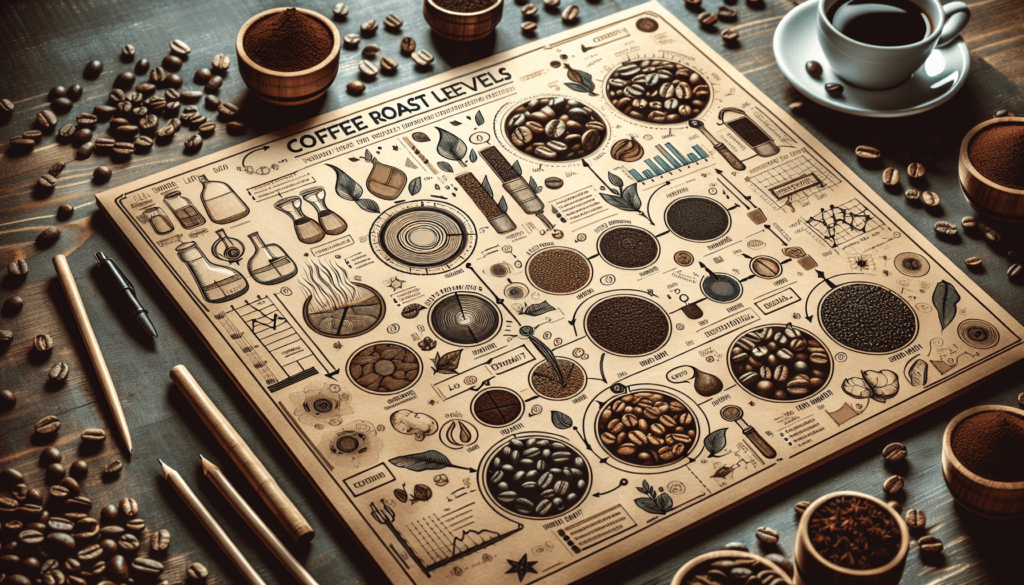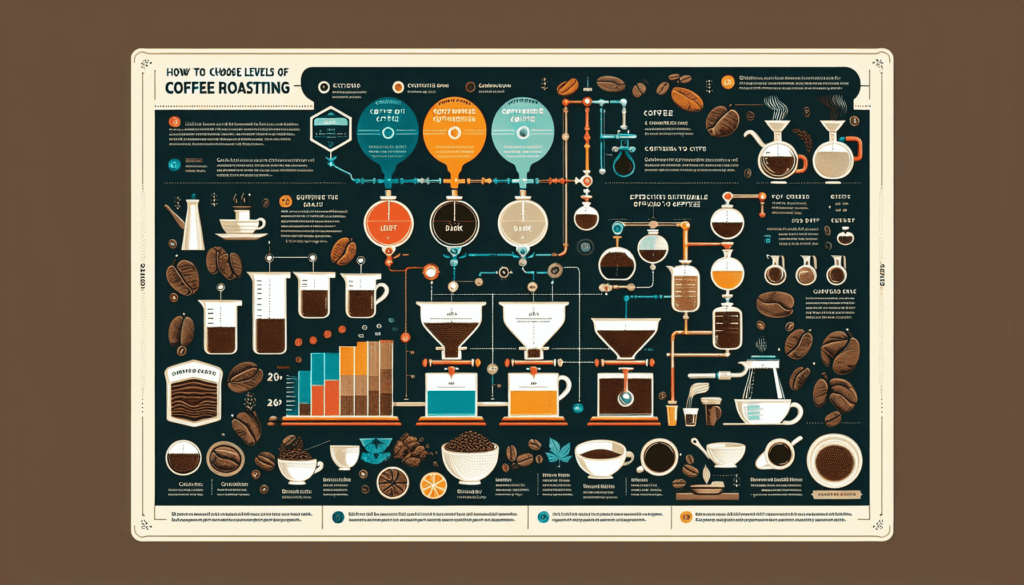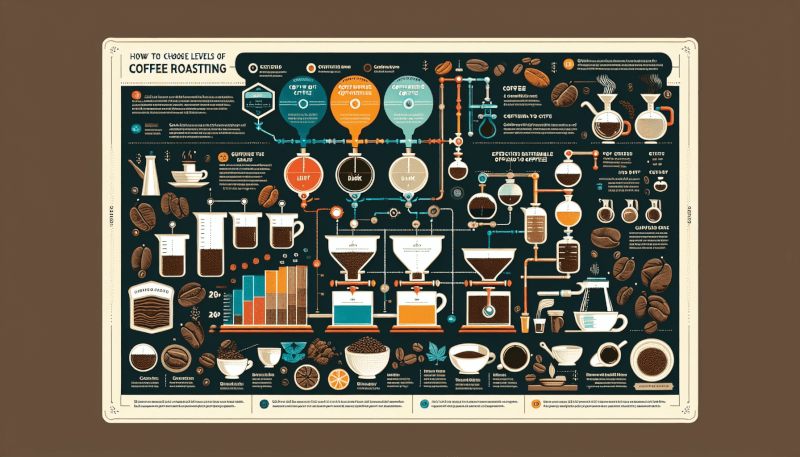If you’ve ever found yourself standing in front of a menu or staring at a bag of coffee wondering what “light roast” or “dark roast” really mean, this guide is here to help. Whether you’re a coffee aficionado or just starting your caffeine journey, understanding the different coffee roast levels is essential in discovering your perfect cup of joe. From delicate and bright flavors to bold and rich notes, we’ll break down the characteristics of each roast level, so you can confidently choose the coffee that suits your taste buds. Get ready to embark on a flavorful adventure through the world of coffee roasting.

Light Roast
What is a light roast?
A light roast refers to coffee beans that have been roasted for a relatively shorter period of time, usually resulting in a lighter color and a milder flavor. This roast level is known for preserving the beans’ natural characteristics and highlighting their origin flavors.
Characteristics of a light roast
Light roasts are typically light brown in color, almost resembling a cinnamon shade. They have a light body, high acidity, and vibrant, fruity or floral flavors. Due to the shorter roasting time, light roasts retain more caffeine compared to darker roasts. The beans also maintain their original moisture content, resulting in a crisp and bright taste.
Popular light roast coffees
Some well-known light roast coffees include:
-
Ethiopian Yirgacheffe: This coffee is renowned for its delicate floral aroma and sweet, fruity flavors. It often exhibits notes of citrus, jasmine, and berries.
-
Costa Rican Tarrazu: Known for its vibrant acidity and bright flavors, Costa Rican Tarrazu beans offer a clean and crisp cup. They are often characterized by notes of lemon, almond, and caramel.
-
Colombian Supremo: Colombian Supremo beans are famous for their balanced acidity and medium body. They feature a smooth and clean flavor profile with hints of chocolate, nuttiness, and caramel.
Medium Roast
What is a medium roast?
A medium roast falls somewhere between a light and dark roast in terms of flavor and color. It is a popular roast level that offers a balance between acidity and richness, allowing for a more nuanced coffee drinking experience.
Characteristics of a medium roast
Medium roasts have a medium-brown color, resembling milk chocolate, and possess a fuller body compared to light roasts. They showcase a balanced acidity and a slightly sweeter flavor profile. Medium roasts often highlight the natural sweetness of the coffee beans while still allowing some origin flavors to shine through.
Popular medium roast coffees
Some popular medium roast coffees include:
-
Guatemalan Antigua: These beans typically exhibit a well-rounded flavor profile with medium acidity and a smooth body. They often have notes of chocolate, caramel, and toffee, and sometimes exhibit hints of floral and nutty flavors.
-
Brazilian Santos: Brazilian Santos beans are known for their low acidity and rich, nutty flavors. They are often versatile and can be used as a base for espresso blends or enjoyed on their own, offering a mild and pleasant cup.
-
Mexican Chiapas: Mexican Chiapas beans have a medium body and acidity, with flavors ranging from nutty and chocolatey to fruity and even floral. They are known for their sweetness and smooth finish.
Dark Roast
What is a dark roast?
A dark roast refers to coffee beans that have been roasted for a longer duration, resulting in a darker color and bolder, more intense flavors. Dark roasts often possess a smoky or roasted taste, making them ideal for those who prefer a rich and robust cup of coffee.
Characteristics of a dark roast
Dark roasts have a deep brown to almost black color, with oils visible on the surface of the beans. They have a lower acidity than lighter roasts, resulting in a smoother, fuller-bodied cup. Dark roasts often showcase more caramelization and roasted flavors, sometimes with hints of bitter chocolate or charred caramel.
Popular dark roast coffees
Some popular dark roast coffees include:
-
Italian Roast: Italian Roast is a classic dark roast that embodies a bold and robust flavor profile. It is known for its heavy body, low acidity, and smoky, caramelized flavors. The beans are often used for espresso due to their strong and intense characteristics.
-
French Roast: French Roast is one of the darkest roast levels, offering a strong and bold cup of coffee. It has a smoky and bittersweet flavor, often accompanied by charred undertones. The beans are typically shiny and oily, making them well-suited for a strong espresso or a dark, full-bodied brew.
-
Sumatra Mandheling: This coffee from Indonesia is famous for its earthy, complex flavors. It is characterized by its low acidity, heavy body, and notes of dark chocolate, tobacco, and cedar. The dark roast brings out the unique characteristics of the beans, resulting in a rich and robust cup.
Origin and Bean Type
How origin impacts roast levels
The origin of coffee beans plays a significant role in determining the ideal roast level. Different regions produce beans with distinct flavor profiles, acidity levels, and overall characteristics. For example, beans from Central and South America are often well-suited for medium roasts due to their balanced acidity and sweetness, while African beans with their vibrant fruity and floral flavors are often preferred in lighter roasts.
Popular coffee beans and their roast preferences
-
Colombian beans: Colombian beans are versatile and can be roasted to various levels, but they are commonly enjoyed as a medium roast. This roast level allows their balanced acidity and sweet, nutty flavors to shine through.
-
Ethiopian beans: Ethiopian beans are known for their bright acidity and distinct fruity flavors. They often fare well as a light roast to highlight their delicate and floral characteristics.
-
Brazilian beans: Brazilian beans are often roasted to a medium or dark level. Dark roasting helps to accentuate their nutty and chocolaty flavors, while maintaining a rich body with less acidity.

Roasting Process
Stages of the roasting process
The roasting process involves several stages that gradually transform green coffee beans into their desired roast level:
-
Drying: The beans are exposed to high heat to remove moisture content and reduce their weight.
-
First Crack: The beans undergo the first audible crack, indicating that the internal moisture is being released and the beans are expanding.
-
Development: The roast continues beyond the first crack, with sugars caramelizing and flavors intensifying. Different roast levels are achieved depending on the desired taste profile.
How different temperatures affect roast levels
Roast levels are influenced by the temperature at which the beans are roasted. Light roasts are typically roasted at lower temperatures, around 356°F (180°C) to 401°F (205°C). Medium roasts are roasted between 410°F (210°C) and 428°F (220°C), while dark roasts require temperatures ranging from 437°F (225°C) to 446°F (230°C) or higher. Higher temperatures result in darker roasts by allowing the beans to caramelize further and develop the characteristic flavors of a dark roast.
Acidity and Flavor Profiles
How acidity varies among different roasts
Acidity in coffee refers to a natural, desirable quality that adds brightness and complexity to the flavor profile. Light roasts often showcase higher acidity, which can range from citrusy and tangy to floral and vibrant. Medium roasts tend to have a more balanced acidity, while dark roasts exhibit lower acidity levels, resulting in a smoother, less tart taste.
Flavor profiles associated with each roast level
Light roasts emphasize the original flavors of the beans, often exhibiting vibrant and complex taste profiles. Fruity, floral, and tea-like notes are commonly found in light roasts. Medium roasts strike a balance between origin characteristics and caramelized flavors, offering a combination of sweetness, nuttiness, and mild acidity. Dark roasts are known for their bolder, more intense flavors, often associated with smokiness, chocolate, and roasty undertones.

Caffeine Content
Does roast level affect caffeine content?
Contrary to popular belief, the roast level does not significantly impact the caffeine content of coffee. While darker roasts may initially contain slightly more caffeine due to the larger bean size, the roasting process itself burns off some of the caffeine. However, the difference in caffeine content between roast levels is minimal, and factors such as bean variety and brewing method have a more significant influence on caffeine levels.
Common misconceptions about caffeine in coffee
One common misconception is that lighter roasts contain more caffeine because they are less roasted. In reality, the difference in caffeine content between roast levels is negligible. Additionally, the myth that darker roasts are stronger in taste and caffeine content is incorrect. The strength of coffee is determined by the coffee-to-water ratio and the brewing method rather than the roast level.
Brewing Recommendations
Best brewing methods for each roast level
-
Light roasts: Light roasts are best enjoyed using brewing methods that allow the delicate flavors to shine through, such as pour-over, Chemex, or AeroPress. These methods highlight the brightness and complexity of the beans.
-
Medium roasts: Medium roasts lend themselves well to a range of brewing techniques, including drip brewing, French press, and espresso. These methods can enhance the balanced flavors and medium body of the coffee.
-
Dark roasts: Dark roasts are well-suited for methods that can extract the intense flavors and oils effectively, such as espresso machines, French press, or Moka pot. These methods amplify the boldness and rich characteristics of the beans.
Tips for brewing a perfect cup based on roast level
Regardless of the roast level, there are a few general tips to brew a delicious cup of coffee:
-
Use freshly roasted beans: Freshness is crucial for optimal flavor, so try to purchase beans that have been recently roasted.
-
Grind the beans just before brewing: Grinding the beans just before brewing helps preserve the flavors and aromas.
-
Adjust the grind size: Different brewing methods require different grind sizes, so experiment to find the right setting for your preferred method.
-
Control water temperature: The ideal water temperature for brewing coffee is between 195°F (90°C) and 205°F (96°C). Use a thermometer or kettle with temperature control to achieve the desired temperature.
-
Maintain consistent brew time: Consistency in brew time helps produce a consistent flavor profile. Use a timer to ensure proper extraction.
-
Experiment with coffee-to-water ratio: Adjusting the coffee-to-water ratio allows you to achieve your preferred strength. Start with a recommended ratio and adjust to taste.

Choosing the Right Roast
Considerations when choosing a roast level
When selecting a roast level, consider the following factors:
-
Flavor preferences: Think about the taste profile you enjoy the most. Light roasts offer bright and delicate flavors, while dark roasts provide boldness and intensity. Medium roasts strike a balance between the two.
-
Brewing method: Some brewing methods work best with specific roast levels. Consider the brewing method you use most frequently and choose a roast level that complements it well.
-
Time of day: The time of day can influence your roast preference. Light roasts with their higher acidity and vibrant flavors are often enjoyed in the morning, while dark roasts can be savored in the evening due to their deep, rich qualities.
Personal preferences and taste preferences
Ultimately, the best roast level is the one that aligns with your personal preferences and taste preferences. Experiment with different roast levels and try coffees from various origins to discover the flavors that resonate with you the most. Coffee is a versatile beverage that offers a wide range of taste experiences, so don’t hesitate to explore and enjoy the diverse world of coffee roasts.
Storage and Freshness
How to store different roast levels
To maintain the freshness of your coffee, consider the following storage tips:
-
Use airtight containers: Store your coffee beans in airtight containers to protect them from exposure to air, humidity, and odors.
-
Avoid direct sunlight: Keep your coffee away from direct sunlight, as UV rays can degrade the quality and flavor of the beans.
-
Store in a cool, dry place: Coffee beans are sensitive to moisture and heat, so store them in a cool, dry place, away from the stove or other heat sources.
Tips for maintaining coffee freshness
To ensure the freshness of your coffee, follow these tips:
-
Purchase whole beans: Whole beans have a longer shelf life than ground coffee. Grind only the amount you need just before brewing.
-
Plan your consumption: Buy coffee in quantities that match your consumption rate. Avoid stockpiling excessive amounts of coffee, as it may lead to staleness.
-
Avoid freezing coffee: While freezing coffee can prolong its shelf life, it can also introduce moisture and affect the flavor. It is generally recommended to avoid freezing unless absolutely necessary.
-
Use coffee within its peak freshness: Coffee is best consumed within a few weeks of its roast date to enjoy optimal flavors. Be mindful of the freshness dates provided on the packaging and prioritize using beans within that time frame.
By understanding the different coffee roast levels, you can make informed decisions about the type of coffee that suits your preferences and brewing methods. Whether you prefer the bright and lively flavors of a light roast, the balance and versatility of a medium roast, or the bold richness of a dark roast, there is a roast level to satisfy every coffee enthusiast. So grab your favorite roast, brew a cup, and savor the distinct nuances and flavors that each roast level has to offer.



